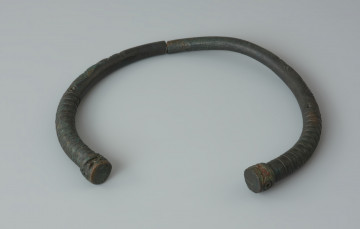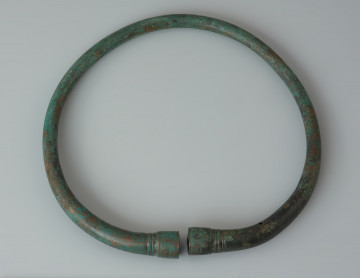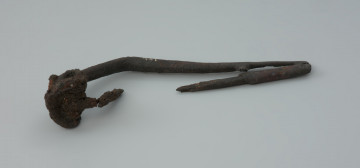
Copy of type I crown necklace (Kostrzewski)
National Museum in Szczecin
Part of the collection: Antiquity
The bronze fibula represents a type with a profiled button, which was rare in Western Pomerania. The design and the type decoration are the elements indicating the time of its origin - the earlier pre-Roman period, 2nd - 1st centuries BC. The main function of these accessories was to fasten elements of clothing. In the last centuries before our era, the fibulae replaced pins that were used for that purpose before. Fibulae with a button on the inverted foot is an ornament typical for the Celtic people, who in that period developed a thriving material culture and complex rituals. This culture, called at La Tène after the archaeological site in Switzerland, had a great influence on the northern European tribes. This influence is called the “latenization” of local cultures and included also those inhabiting Western Pomerania. This process is best illustrated by the furnishing of graves, in which new elements of garments appeared, such as fibulae, neck-rings, and elements of belts. The area of Western Pomerania between the Odra and Ina Rivers was then inhabited by the Jastorf culture, named after the town of Jastorf in Lower Saxony and considered to be Germanic. This population preserved its own rituals. The cemeteries of the Jastorf culture contain only inhumation graves with no weapons among the grave goods, which distinguishes them from the Celtic ones. On the other hand, the middle part of Pomerania was occupied by the people of the Oksywie culture (a cemetery of this culture was discovered in the town of Oksywie) who practiced the ritual of equipping the dead warriors with weapons, according to a Celtic custom. According to archival information, the presented fibula was found in 1937 or earlier, in a swamp by the road leading from Goleniów to Kamień Pomorski, “at the depth of 80 cm”. It is listed in the archaeological literature as a swamp deposit, meaning an object ritually thrown into a swamp or lake. The private catalog of the Szczecin researcher Hans Jürgen Eggers also lists " La Tène urns" from Marszewo. To this day it has not been possible to establish a connection between this fibula and the graves mentioned.
Bartłomiej Rogalski
Author / creator
Dimensions
cały obiekt: height: 3.6 cm, width: 7.6 cm
Object type
pin (fastener)
Technique
metallurgical; cast
Creation time / dating
Creation / finding place
Owner
Muzeum Narodowe w Szczecinie
Identification number
Location / status

National Museum in Szczecin

National Museum in Szczecin

National Museum in Szczecin
DISCOVER this TOPIC
National Museum in Szczecin
DISCOVER this PATH
Educational path